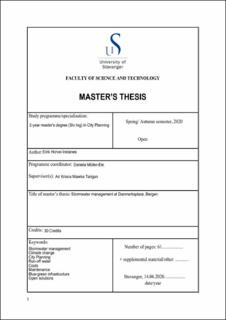| dc.contributor.advisor | Tarigan, Ari Krisna Mawari | |
| dc.contributor.author | Instanes, Eirik Horvei | |
| dc.coverage.spatial | Norway, Bergen | en_US |
| dc.date.accessioned | 2020-10-02T13:00:07Z | |
| dc.date.available | 2020-10-02T13:00:07Z | |
| dc.date.issued | 2020-06-15 | |
| dc.identifier.uri | https://hdl.handle.net/11250/2680974 | |
| dc.description | Master's thesis in City and regional planning | en_US |
| dc.description.abstract | Stormwater management has increasingly become more important in recent times in urban planning. One of the reasons for this is climate change. More rainfall is occurring in form of more frequent, intense rainfall, and research say this trend will continue. This is especially true for western Norway and northern Norway, which will experience the greatest increase in rainfall. Something else, which has also made stormwater management more important, is the desire to densify along central areas and public transport axes due to the population growth. As a result, green permeable areas have been replaced with dense impermeable surfaces. Dense impermeable surfaces lead to less infiltration and a higher runoff velocity. When densification and climate change occur simultaneously without upgrading the stormwater infrastructure, problems often arise. This has particularly significant consequences when the piping infrastructure is shared by stormwater and sewage.
The underpass at Danmarksplass in Bergen is one of the areas which are struggling with floods following major rainfall events. The piping infrastructure is mostly shared by stormwater and sewage, and the infrastructure is not well enough equipped for neither today's nor future’s rainfall events. During the night before 26.09.2018, a heavy rainfall occurred, and the underpass was once againwith water. This rainfall is considered as an event that statistically occurs every 5 years. The rainfall was much less intense than the type of rainfall the underpass in theory should be dimensioned for. Since the underpass is so important and highly trafficked by pedestrians and cyclists, measures should be made to improve the stormwater management at Danmarksplass.
To find the answer to why the underpass is struggling with floods and what solves the problem best, there has been done a literature study, an inspection of the area, an analysis with calculations, and finally a discussion. There has been made research on planning methods in the field of stormwater management, types of infrastructure which are available on the market and sought inspiration in other innovative projects which have previously been planned. Furthermore, 3 scenarios were established, where scenario 1 solely used traditional grey infrastructure, scenario 2 solely used blue-green infrastructure and scenario 3 had a combination of traditional grey infrastructure and blue-green infrastructure. The scenarios were further assessed on 5 different topics: costs, how well they manage stormwater, their impact on the urban environment and biodiversity and the amount of maintenance required. Finally, it was concluded that scenario 3 was the best solution to solve the stormwater problem at Danmarksplass. | en_US |
| dc.description.abstract | Overvannshåndtering har i nyere tider blitt viktigere innen planlegging. En av grunnene til dette er at klimaet er i endring. Det oppstår mer nedbør i form av hyppige, intense regnskyll, og forskning sier at denne trenden vil fortsette. Dette gjelder spesielt på Vestlandet og Nord-Norge som vil oppleve den største nedbørsøkningen. Noe annet som også har gjort at overvannshåndtering blir viktigere er befolkningsvekst og et ønske om å fortette langs sentrale områder og kollektiv akser. Dette har ført til at grønne permeable områder har blitt erstattet med tette flater. Resultatet av dette er mindre infiltrasjon og høyere avrenningshastighet. Når fortetting og klimaendringer foregår samtidig uten at overvannshåndteringen oppgraderes, oppstår det ofte problemer. Dette får spesielt store konsekvenser når rørinfrastrukturen deles med avløpsvann.
Undergangen på Danmarksplass i Bergen er en av områdene som er utsatt for flom etter store nedbørshendelser. Rørinfrastrukturen deles stort sett av overvann og avløpsvann, og infrastrukturen er ikke godt nok rustet for hverken dagens eller fremtidens nedbørshendelser. Natt til 26.09.2018 kom det store mengder nedbør og undergangen ble nok en gang fylt med vann. Denne hendelsen er vurdert som en hendelse som statistisk sett vil kunne inntreffe hvert 5. år. Nedbøren var mye mildere enn den type nedbørshendelse undergangen i teorien skal være dimensjonert for. Siden undergangen er så viktig og svært trafikkert av gående og syklende, bør tiltak bFor å undersøke hvorfor gangtunnelen er utsatt for flommer, og hva som løser problemet best, har det blitt gjort en litteratur studie, en befaring av området, en analyse med beregninger, og til slutt en diskusjon. Det har blitt forsket på ulike planleggingsmetoder innen overvannshåndtering, typer infrastruktur som finnes på markedet og søkt inspirasjon i noen andre innovative prosjekt som tidligere har blitt planlagt. 3 scenarioer ble videre dannet, hvor scenario 1 kun brukte tradisjonelle grå løsninger, scenario 2 kun brukte blå-grønne løsninger og scenario 3 brukte en kombinasjon av tradisjonelle grå løsninger og blå-grønn infrastruktur. Scenariene ble videre vurdert innen 4 tema: kostnad, deres påvirkning på det urbane miljø og det biologiske mangfold og mengden vedlikehold som kreves. Til slutt ble det konkludert med at scenario 3 var den beste løsningen for å løse problemet på Danmarksplass. | en_US |
| dc.language.iso | eng | en_US |
| dc.publisher | University of Stavanger, Norway | en_US |
| dc.relation.ispartofseries | Masteroppgave/UIS-TN-ISØP/2020; | |
| dc.subject | urban design | en_US |
| dc.subject | byplanlegging | en_US |
| dc.subject | klimaendringer | en_US |
| dc.subject | overvannshåndtering | en_US |
| dc.title | Stormwater management at Danmarksplass, Bergen | en_US |
| dc.type | Master thesis | en_US |
| dc.description.version | submittedVersion | en_US |
| dc.subject.nsi | VDP::Samfunnsvitenskap: 200::Urbanisme og fysisk planlegging: 230 | en_US |
